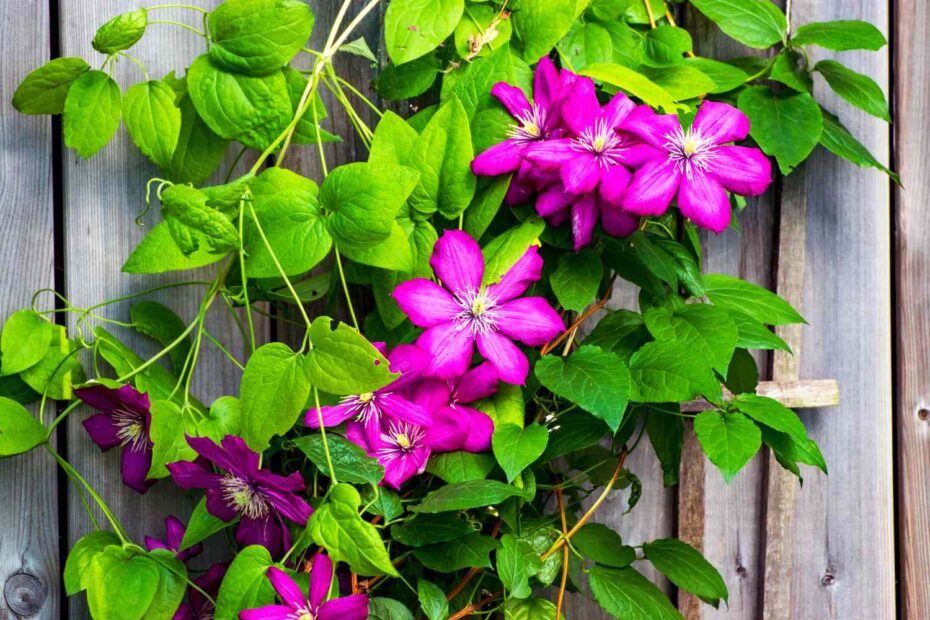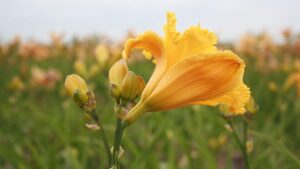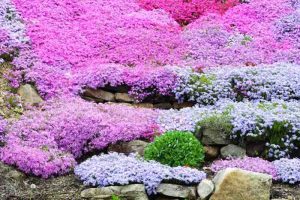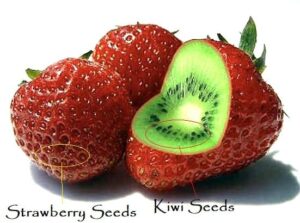Trellis Flowers: What Grows Best?
When you’re looking to add a touch of beauty and fragrance to your garden, trellises are a great option.
But not all flowers are created equal when it comes to growing on trellises. Some varieties are better suited to this type of support than others.They can be used to support climbing plants, creating a vertical display that’s both eye-catching and functional..
In this article, we’ll take a look at some of the best flowers for growing on trellises. We’ll discuss their different characteristics, as well as how to plant and care for them. So whether you’re a beginner gardener or you’re just looking for some new ideas, read on for all the information you need to know about growing trellises flowers!

Trellis Flowers: What Grows Best?
Trellises are a great way to add vertical interest to your garden, and they can also be used to grow a variety of flowers. Here are some of the best flowers to grow on a trellis:
- Climbing roses are a classic choice for trellises, and they come in a variety of colors and fragrances.
- Honeysuckle is another popular choice, and it produces beautiful blooms that attract bees.
- Morning glories are a fast-growing vine that produces delicate flowers in a variety of colors.
- Trumpet vines are a tropical vine that produces large, trumpet-shaped flowers.
- Clematis is a deciduous vine that produces beautiful flowers in a variety of colors.
When choosing flowers for your trellis, it’s important to consider the size and shape of the trellis, as well as the amount of sun and shade it receives. Most flowers will do well on a trellis, but some varieties are better suited for specific conditions. For example, climbing roses need full sun, while honeysuckle and morning glories can tolerate partial shade.
Trellises are a great way to add beauty and interest to your garden, and they’re also a relatively easy way to grow flowers. With a little planning, you can create a stunning trellis garden that will add color and fragrance to your outdoor space for years to come.
Table of Trellis Flower Options
| Flower | Type of Trellis | Sunlight Requirements |
|---|---|---|
| Climbing roses | Vertical | Full sun |
| Honeysuckle | Vertical | Partial shade |
| Morning glories | Vertical | Full sun |
| Trumpet vines | Vertical | Full sun |
| Clematis | Vertical or A-frame | Full sun |
If you’re new to gardening, trellises can be a great way to add some vertical interest to your space and grow beautiful flowers. Trellises also help to support plants that can get top-heavy, such as climbing roses and clematis.
When choosing trellis flowers for beginners, it’s important to consider the following factors:
- Sunlight: Most trellis flowers need full sun to partial shade.
- Water: Trellises can dry out quickly, so it’s important to water your plants regularly.
- Fertilizer: Trellis flowers will benefit from a monthly application of fertilizer.
Here are some of the best trellis flowers for beginners:
- Clematis: Clematis is a beautiful flowering vine that comes in a variety of colors and sizes. It’s easy to grow and care for, and it’s a great choice for beginners.
- Honeysuckle: Honeysuckle is a fragrant vine that blooms in the spring and summer. It’s a great choice for adding a sweet scent to your garden.
- Morning glory: Morning glory is a fast-growing vine that produces beautiful flowers in a variety of colors. It’s a great choice for covering trellises quickly.
- Rose: Roses are a classic choice for trellises. They come in a variety of colors and sizes, and they’re sure to add beauty to your garden.
- Wisteria: Wisteria is a beautiful flowering vine that produces clusters of fragrant flowers in the spring. It’s a great choice for creating a dramatic statement in your garden.
With a little care, these trellis flowers can add beauty and interest to your garden for years to come.
Choosing the Right Trellis for Your Flowers
Choosing the Right Trellis for Your Flowers
When choosing a trellis for your flowers, there are a few factors to consider. First, you need to decide what type of flowers you will be growing. Some flowers, such as climbing roses, need a sturdy trellis that can support their weight. Other flowers, such as clematis, can grow on a more lightweight trellis.
Once you know what type of flowers you will be growing, you can start to consider the size and shape of the trellis. The trellis should be large enough to accommodate the mature size of the flowers, and it should be in a location where the flowers will get plenty of sunlight.
Here are a few tips for choosing the right trellis for your flowers:
- Consider the weight of the flowers. If you are growing heavy flowers, such as climbing roses, you will need a sturdy trellis that can support their weight.
- Choose a trellis that is the right size for your flowers. The trellis should be large enough to accommodate the mature size of the flowers, and it should be in a location where the flowers will get plenty of sunlight.
- Consider the shape of the trellis. There are many different shapes of trellises available, so you can choose one that fits your needs and your garden.
Here are a few examples of trellises that are suitable for different types of flowers:
- For climbing roses, a sturdy trellis made of wood or metal is a good option. The trellis should be at least 6 feet tall and wide enough to support the weight of the roses.
- For clematis, a lightweight trellis made of wire or bamboo is a good option. The trellis should be about 4 feet tall and wide enough to support the weight of the clematis.
- For other vining flowers, such as morning glories and trumpet vines, a trellis made of wood or metal is a good option. The trellis should be about 3 feet tall and wide enough to support the weight of the flowers.
By following these tips, you can choose the right trellis for your flowers and help them to grow to their full potential.
Table of Trellis Types
| Trellis Type | Suitable Flowers | Weight Capacity | Size |
|---|---|---|---|
| Wood Trellis | Roses, clematis, morning glories | Heavy | 6 feet tall and wide |
| Metal Trellis | Roses, clematis, morning glories | Heavy | 6 feet tall and wide |
| Wire Trellis | Clematis, morning glories, trumpet vines | Light | 4 feet tall and wide |
| Bamboo Trellis | Clematis, morning glories, trumpet vines | Light | 4 feet tall and wide |
Trellis flowers are a great way to add beauty and interest to your garden. They can be grown on a variety of trellises, from simple wooden structures to elaborate metalwork. Trellis flowers come in a wide variety of shapes, sizes, and colors, so you can find the perfect ones to complement your garden.
Planting Trellis Flowers
The best time to plant trellis flowers is in the spring, after the last frost. Choose a location that gets full sun or partial shade. The soil should be well-drained and rich in organic matter.
Dig a hole that is twice the width of the root ball and deep enough so that the plant will be level with the surrounding soil. Place the plant in the hole and fill it with soil. Water the plant thoroughly.
Caring for Trellis Flowers
Trellis flowers are relatively easy to care for. They need regular watering, especially during dry spells. Fertilize them monthly with a balanced fertilizer.
To keep your trellis flowers looking their best, deadhead them regularly. This will encourage new blooms. You may also need to prune them back occasionally to keep them from getting too overgrown.
Troubleshooting Trellis Flowers
If your trellis flowers are not blooming, there are a few things you can check. First, make sure that they are getting enough sunlight. Trellis flowers need at least six hours of sunlight per day to bloom properly.
Second, check the soil moisture. Trellis flowers need to be watered regularly, but they should not be overwatered. Allow the soil to dry out slightly between waterings.
check for pests. Trellis flowers can be affected by a variety of pests, including aphids, mites, and caterpillars. If you see any pests, treat them with an appropriate insecticide.
Trellis Flowers: A List of Some of the Best Varieties
- Clematis: Clematis are a popular choice for trellises, and they come in a wide variety of colors, shapes, and sizes. Some of the best varieties for trellises include ‘Nelly Moser’, ‘The President’, and ’Comtesse de Bouchaud’.
- Honeysuckle: Honeysuckle is another good choice for trellises. It is a fast-growing vine that produces fragrant flowers in the summer. Some of the best varieties for trellises include ’Lonicera periclymenum’, ‘Lonicera japonica’, and ‘Lonicera sempervirens’.
- Wisteria: Wisteria is a beautiful flowering vine that is perfect for trellises. It produces large, drooping clusters of flowers in the spring. Some of the best varieties for trellises include ‘Wisteria sinensis’, ‘Wisteria floribunda’, and ‘Wisteria brachybotrys’.
- Trumpet Vine: Trumpet vine is a fast-growing vine that produces showy flowers in the summer. It is a good choice for trellises that need to be covered quickly. Some of the best varieties for trellises include ‘Campsis radicans’, ‘Campsis grandiflora’, and ‘Campsis tagliabuana’.
- Jasmine: Jasmine is a fragrant vine that is perfect for trellises. It produces small, white flowers in the summer. Some of the best varieties for trellises include ‘Jasminum officinale’, ‘Jasminum sambac’, and ‘Jasminum polyanthum’.
Pruning and Training Trellis Flowers
Pruning and Training Trellis Flowers
Pruning and training trellis flowers is essential for keeping them healthy and looking their best. By following these simple tips, you can help your trellis flowers reach their full potential.
When to Prune
The best time to prune trellis flowers is in late winter or early spring, before the new growth begins. This will help to remove any dead or damaged branches and encourage new growth.
How to Prune
When pruning trellis flowers, it is important to use sharp, clean shears. Make your cuts just above a leaf node, which is where the new growth will emerge. Be sure to remove any branches that are crossing or rubbing against each other, as this can lead to disease.
Training
In addition to pruning, it is also important to train your trellis flowers. This can be done by tying the stems to the trellis with soft garden ties. As the plants grow, you will need to adjust the ties to keep them supported.
By following these simple tips, you can help your trellis flowers reach their full potential.
Harvesting and Enjoying Your Trellis Flowers
Harvesting and Enjoying Your Trellis Flowers
Once your trellis flowers have bloomed, it’s time to harvest them and enjoy their beauty and fragrance. Here are a few tips:
- Harvesting time: Most trellis flowers are best harvested in the morning, when the flowers are fresh and the petals are at their fullest.
- How to harvest: Gently grasp the stem of the flower and pull it away from the trellis. Be careful not to damage the flower.
- What to do with your flowers: You can enjoy your trellis flowers fresh, or you can dry them for later use. To dry your flowers, simply place them in a cool, dry place with good air circulation. The flowers will be dry when the petals are crisp and brittle.
Once your flowers are dry, you can use them in a variety of ways. You can:
- Make a floral arrangement: Arrange your dried flowers in a vase or other container. You can add other dried flowers, greenery, or even some fruit to create a beautiful and unique arrangement.
- Use in potpourri: Add your dried flowers to potpourri to create a fragrant and inviting scent.
- Make a wreath: Use your dried flowers to make a wreath for your door or mantel. This is a beautiful way to show off your flowers and add a touch of nature to your home.
Trellis flowers are a beautiful and versatile addition to any garden. By harvesting and enjoying your trellis flowers, you can extend their beauty and fragrance for months to come.
Resources
1. The Spruce: “10 Best Trellis Plants for Every Garden”
2. Gardening Know How: “15 Best Trellis Plants for Your Garden”
Insights and Conclusions
Trellis Flowers: What Grows Best?
Trellises are a great way to add height and interest to your garden, and they can also be used to grow a variety of flowers. When choosing flowers for your trellis, it’s important to consider the size, shape, and color of the flowers, as well as the amount of sun and shade the trellis receives.
Here are a few of the best flowers for trellises:
- Climbing roses are a classic choice for trellises, and they come in a variety of colors and fragrances. Roses need full sun and well-drained soil.
- Morning glories are another popular choice for trellises. They bloom in a variety of colors, and they’re easy to grow. Morning glories need full sun and well-drained soil.
- Clematis are beautiful flowers that come in a variety of colors and shapes. Clematis need full sun or partial shade and well-drained soil.
- Honeysuckle is a fragrant vine that blooms in clusters of small white flowers. Honeysuckle needs full sun or partial shade and well-drained soil.
- Passionflowers are exotic flowers that bloom in a variety of colors. Passionflowers need full sun and well-drained soil.
With so many beautiful flowers to choose from, you’re sure to find the perfect ones to add to your trellis. So what are you waiting for? Start growing today!
- Cat Palm vs Majesty Palm: Which Should You Choose? - June 30, 2024
- Flowers That Survive Winter: Discover the Exceptional No. 5 - June 30, 2024
- The Ultimate Guide to the Growth and Care of the Black Pagoda Lipstick Plant - June 29, 2024





